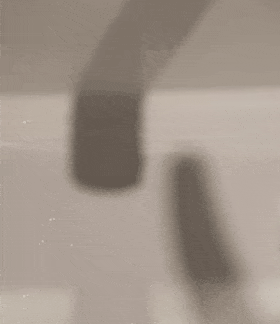Why do two blurry shadows, when brought close to each other, appear to "bulge" and merge?
Physics Asked by TheLastAirbender on April 17, 2021
I have recently noticed that when two objects with blurry shadows cast by the same light source are brought close to each other, their shadows appear to merge in a way where one shadow appears to "bulge" and meet the other even though the two objects are not in contact. I noticed this in my bathroom while I was brushing my teeth. Here is a gif of the same:
I thought that this might have to do with diffraction (although diffraction is a phenomenon that only occurs when light meets objects that are of size comparable to its wavelength, which is not the case here) or the umbrae and penumbrae of the blurry shadows but I’m not sure.
I am aware of this question that seems to ask about a similar phenomenon, but have decided to post mine anyway because:
- It is related to the shadows cast by the Sun while in my case it is just a bathroom light
- The answer to it, although a fantastic one, concludes that this effect is captured by the camera due to the limitations of its sensor even though I was able to capture it on my phone with high resolution and the video is indistinguishable from what I saw with my own eyes.
- Moreover, my bathroom is not brightly lit at all, which is what the answer suggests is required for this effect to be seen or captured by the camera.
Hence, I am inclined to believe that there is something more to it.
I was also able to easily recreate this effect using my table lamp, and found that the object that is further from the light source seems to be the one whose shadow "bulges" outward towards the shadow of the object closer to the source of light. This agrees with the gif above as my finger in it is closer to the bathroom light than the faucet, which is the one whose shadow appears to bulge towards the shadow of my finger. It also seems that the blurrier the shadow (i.e. the closer the object is to the light source), the greater is the "bulging" effect although I have not thoroughly tested this.
Does anyone have a clear explanation for this phenomenon?
Edit
While searching about this phenomenon on the web, I came across this Wikipedia page that describes it as the "Shadow blister effect". Although the page is pretty barebones and lacks citations, it seems to agree with my observations about the positions of objects with respect to the light source and each other, and suggests that:
The effect takes place when two objects are located at varying distances between a non-point light source and a backdrop upon which their shadows are cast. As the two objects move transversely such that their shadows approach each other, the object nearest the light source will begin blocking light from reaching the inside of the other object’s penumbra, thereby expanding its umbra. This expansion of the further object’s umbra will continue until the umbras of both objects meet. This effect can be demonstrated and understood using ray theory.
Add your own answers!
Ask a Question
Get help from others!
Recent Answers
- Peter Machado on Why fry rice before boiling?
- haakon.io on Why fry rice before boiling?
- Joshua Engel on Why fry rice before boiling?
- Lex on Does Google Analytics track 404 page responses as valid page views?
- Jon Church on Why fry rice before boiling?
Recent Questions
- How can I transform graph image into a tikzpicture LaTeX code?
- How Do I Get The Ifruit App Off Of Gta 5 / Grand Theft Auto 5
- Iv’e designed a space elevator using a series of lasers. do you know anybody i could submit the designs too that could manufacture the concept and put it to use
- Need help finding a book. Female OP protagonist, magic
- Why is the WWF pending games (“Your turn”) area replaced w/ a column of “Bonus & Reward”gift boxes?
